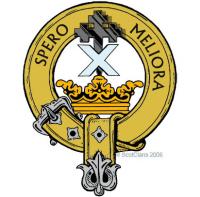
Clan Moffat
As far back as the time of Sir William Wallace, the Moffats were a powerful and influential borders family, who most likely gave their name to the town of Moffat in Dumfriesshire. The progenitor of the clan was a Norseman, William de Mont Alto, who came to Scotland in the tenth century. By the twelfth century the family was important enough to be designated as "de Moffet", proving that their standing was high within the district.
Like many other borders families, the Moffat clan were raiders and reivers, and conducted long-running feuds with their neighbours. Their greatest enemies were the powerful Johnston clan, and the numerous squabbles between the two families culminated in the murder of Robert Moffat, the clan chief, by the Johnstons in the sixteenth century. The Johnstons went on to burn the building in which most of the Moffat family notables had gathered, and slaughtered all those who tried to escape. In one blow, the powerful Moffat clan was all but wiped out. Some seventy years after these events, the Moffat lands passed to the Johnston family, as a result of the Moffats' overwhelming debts.
In later years the Moffats were considered a leaderless clan until 1983 when, after many years of research, Francis Moffat was recognised as the hereditary clan leader.
The Moffat family has always been linked with the church and in the thirteenth century Nicholas de Moffet, was the Bishop of Glasgow. Another notable churchman, the Rev. Robert Moffat, founded the Kuruman mission in Africa and his daughter went on to marry the famous explorer, David Livingstone








